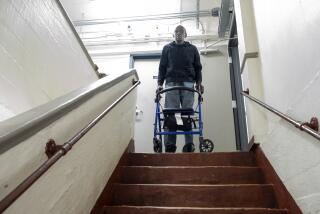Elevator Have You in a Jam? Help May Be Just Hundreds of Miles Away
- Share via
FARMINGTON, Conn. — The elevator helpers at Otis have a little secret. When trying to calm people stuck on elevators, talk about the weather, talk about the kids, but try not to tell them where you are.
Help may only be a phone call away, but it’s a long call away. When someone presses the help button on any of 105,000 elevators across the United States, Canada, Guam or the Caribbean islands, the phone rings in a second-floor office in the center of Connecticut.
“You can’t ask them too many questions because they panic. And you don’t want to tell them you’re in Farmington,” says Yvette Anderson, who has had her share of panic calls.
There was the boy who slipped out of his mother’s view, got into an elevator and mistakenly hit the stop button. (The hard part was comforting the parent, Anderson says.) Then there was the worker at the morgue who got stuck with a casket while the funeral was going on downstairs. (“It worked out,” she says.)
OtisLine, part of the Otis elevator subsidiary of United Technologies Corp., has been directing repair work for elevators in North America since 1983.
Otis is the world’s largest manufacturer of elevators and escalators, although not all companies have service contracts with OtisLine.
Domestic customers include Rockefeller Center in New York, the Stratosphere Hotel in Las Vegas and Disney World in Orlando. But no elevator is out of reach, says Edward Curvino, manager of OtisLine’s North American operations.
OtisLine has more than 2,000 mechanics across North America. They have used planes to get to a broken elevator in Alaska and helicopters have been dispatched to send repair crews to elevators on ships.
*
Trapped passengers, meanwhile, can request that an operator stay on the line until a mechanic arrives. They also can request a phone call to alert someone to their plight.
First shift in Farmington starts with about 40 people answering the phones. Staffing drops to about 30 people in the evening, and only five people work overnight.
There are three types of calls: mechanics wanting information on a job site, customers reporting problems and passengers pushing the emergency button.
Most of the calls Anderson takes during the day are for problems such as elevator doors that won’t close or cars that shake and make noises.
Sitting in front of her computer with her phone headset in place, Anderson looks at a rectangular console above the keyboard. Six calls waiting. She hits the “ready” button. The word “mechanic” flashes on the console screen.
Debra Bernier, who has been working at OtisLine for about a year, estimates she answers 850 to 900 calls a week. She says the best part is chatting with people from all over North America. On this morning, within the span of a minute, she takes calls from Texas, South Carolina and Florida.
“It’s neat to see the diversity, the climate and the accent. But the problem is the same: Their elevator is broken,” Bernier says.
Diane Kennedy switches between French and English. (Other operators are fluent in Spanish.) A 10-year veteran of OtisLine, she briefly describes the technical side of her job, then goes into the stories.
There was the time a trapped woman started screaming because she had to use the bathroom. Then there was the lawyer with a sense of humor who recommended elevator modifications, such as a mirror.
And there was the woman who passed the time talking about her problems with her pregnant teenage daughter.
When help arrived 30 minutes later, the woman said: “I feel so good now that I got it off my chest,” Kennedy recalls.
And, as all the operators know, there are the accidental or curious pushes of the red button.
“All the time you get, ‘Sorry, my son hit the button,’ ” Bernier says. “They don’t realize there’s someone on the other end.”
More to Read
Sign up for The Wild
We’ll help you find the best places to hike, bike and run, as well as the perfect silent spots for meditation and yoga.
You may occasionally receive promotional content from the Los Angeles Times.






